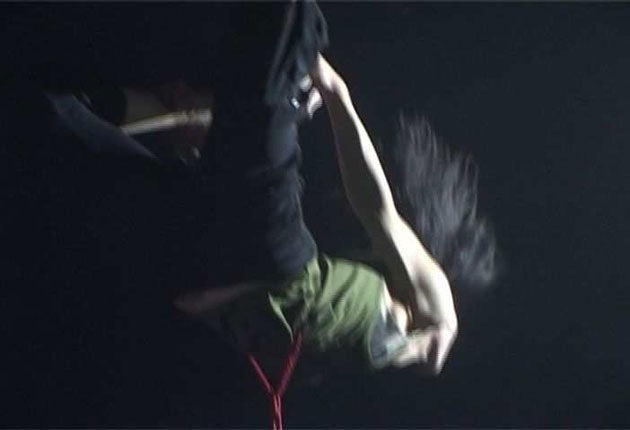Dispersion, ICA, London
Even the input of Turner Prize winner Mark Leckey cannot redeem this pretentious collection of works aimed at theorists

If Mark Leckey's winning the Turner Prize strikes you as a good idea, then clap your hands for joy: he is down to give a lecture – well, actually a "lecture" – at the Institute of Contemporary Arts on 31 January. The flaxen-haired valedictorian will, as ever, tack back and forth between high and low culture, economic theory and Felix the Cat. This alone might make the £8 entry fee a bit of a snip, but there is more.
Leckey's talk is, as I say, not a lecture but a "lecture" – you can mime the inverted commas yourselves – a piece of performance, an artwork. The ICA's ticket is thus a two-for-one deal, not a thing to be sniffed at in these straitened times.
Mark Leckey in the Long Tail is the centrepiece of an exhibition called Dispersion, although it is not the show's defining work. That honour goes to a sequence of silent movies called Film Lexicon of Sexual Practices by a German artist, Maria Eichhorn. If you speak to the attendant nicely, he will project one of these for you: Breast Licking, perhaps, or Cunnilingus, or my personal favourite, Masturbation. This consists of a man playing with his willy for three minutes, although, as with the work in Dispersion as a whole, the performance is flaccid and there is no obvious outcome.
That apart, what have Leckey and Eichhorn to do with each other? Well – and for this we can thank Dispersion's curator, Polly Staples – both are concerned with "how 'ways of seeing' form and define subjectivities". Along the way, the pair stop to "foreground the psychological realm of ... subcultural networks", before settling down to a cosy evening spent "exploring hierarchical codes of the visual lexicon". Being an art critic is usually a nice job, involving wandering around galleries and eating canapés. There are some shows, though, that make you want to run into the street screaming and tearing your hair, and Dispersion is one of them.
Twenty-odd years ago, art schools became departments of universities and the emphasis in teaching shifted from practice to critical theory. Artists being canny creatures, they began to make art that would catch the theorists' eye – pieces that would do their teachers' work for them by writing their own critiques. It happens that Staples wrote the rubric to Dispersion, although Leckey could no doubt have done it just as well; he does, after all, both lecture and "lecture".
What this has left us with is a kind of curating and a kind of art – the two are increasingly one and the same – which is "clever" rather than clever: work that ticks the right theoretical boxes but does nothing to engage the mere viewer, has no visual or emotional presence. Worse, this work is frightfully old hat. Richard Prince has been exploring hierarchical codes for 30 years now; Warhol was foregrounding subcultural networks before Ms Staples was born. The difference between them and the artists in this show is that them oldies have a mute power which precludes easy verbiage; probably because, in that old-fashioned artistic way, their work starts from the image rather than the word.
Enough ranting. You'll have gathered that I do not think Dispersion worth a visit, although if you insist on going, here is what you will find.
Downstairs, Eichhorn aside, is a film by Seth Price which re-edits old films by Seth Price, and an archive piece by Henrik Olesen that re-archives an older archive piece by Henrik Olesen. (Did you know Dorothy Parker called her budgie Onan because he spilled his seed upon the ground?) The corridor outside is hung with handsome Richard-Prince-lite C-prints by Anne Collier. Anything You Want is probably the best thing in this show, although that is not saying much. Upstairs is a kind of action-painting-projection by Hilary Lloyd, which is bearably pretty and bland, and an autobiographical movie by a Japanese ex-bondage model called Hito Steyerl, which is by turns touching and cruel in that manga-comic way. Around the corner from the ICA is the National Gallery, which has works by Velazquez, Raphael, Rembrandt, Goya and Titian.
Institute of Contemporary Arts, London SW1 (020-7930 3647) to 1 Feb
Subscribe to Independent Premium to bookmark this article
Want to bookmark your favourite articles and stories to read or reference later? Start your Independent Premium subscription today.

Join our commenting forum
Join thought-provoking conversations, follow other Independent readers and see their replies